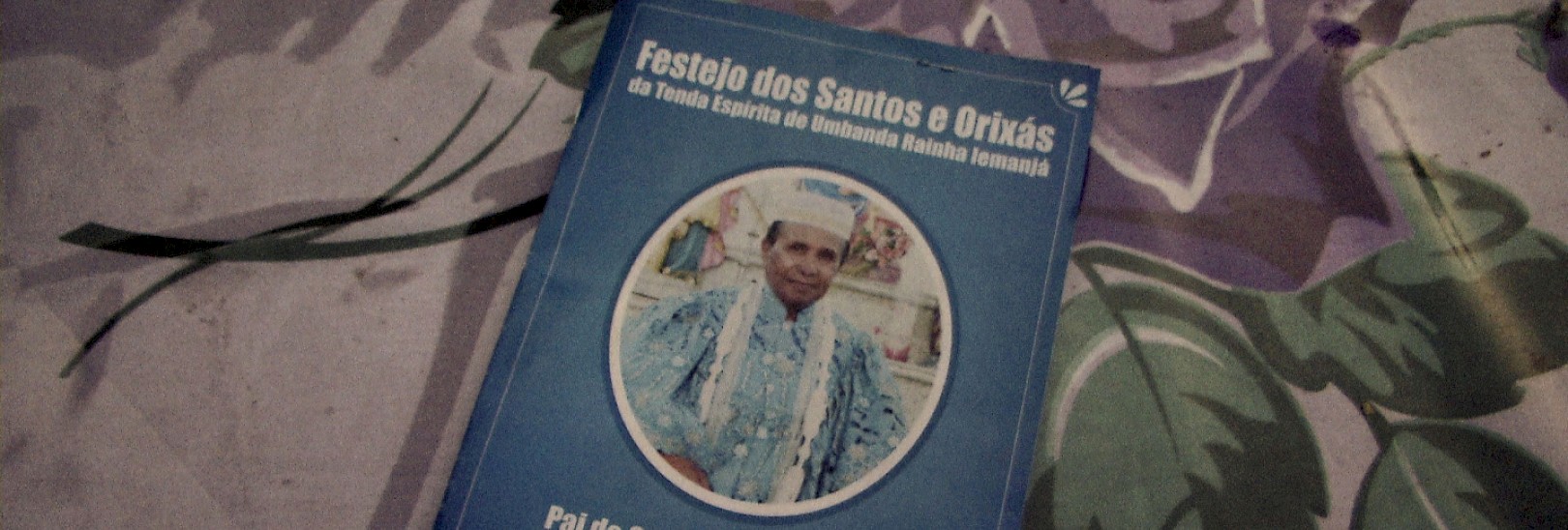Terecô de Codó
He walks in dressed with the gold and sparkles earned through practicing Umbanda. With so many years behind him, only the strength of his ancestors and enchanted ones can assure the vitality he carries within. People from all walks of life, including high-ranking Brazilian politicians, travel to Codó, a town located on a straight line almost 200 miles away from São Luís in Maranhão, in search of his advice and work on how to open the routes of life. And although inland Maranhão may display a lack of material resources – no water, no electricity, no schools – the abundant energy is worth the trip.
“Faith is believing”
Bita do Barão

Everybody there is enchanted and playful, housing spirits and mysterious beings in their dancing bodies for many lives. And there’s no schedule: magic takes place in every corner of Codó, all the time. It’s present in the daily routine, in family talk, in photos on the walls and in the bottom of drawers.
The history of this small town in Maranhão is based upon the foundations of cotton farms sewn by slaves who would flee to freedom strongholds, one of which is Saint Anthony of the Black People (Santo Antônio dos Pretos), a quilombola region from the 1700s. It is also Brazil’s magic capital – home to Terecô and its synonyms like Pajé, Barba Soeira Enchantment (Encantaria de Barba Soeira), or Saint Barbara’s Games (Brinquedo de Santa Bárbara).

A word widely repeated around this area of Maranhão, Terecô was only recently heard by faith researches. The Afro Brazilian religion is a complex quilt, holding mysteries unknown even in Brazil. It’s not simply Tambor de Mina, but it certainly has signs of the crossings with its rituals since the 1900s. It’s a type of Umbanda that, according to its practitioners, has affinities with Catholicism.
“We really like baptisms and blessings of our Saints’ images”
Bita do Barão

From the little that’s advertised about Terecô, it is proudly identified not only as Nagô and Jejê, but also Banto. Its name and meaning would actually emerge from that nation: according to Yeda Pessoa de Castro, a researcher from Bahia, Terecô is worship and celebration by means of drums. Tambor da Mata drums played by skillful hands and maracá heads shaking with seeds are the beats to which the entities, the enchanted arrive: former beings that have lived, but disappeared to inhabit another space-time continuum, an in-between called encantaria. In Maranhão, there are three groups of the enchanted: those by the sweet waters of the lowlands, those by the sea waters knows as Tambor de Mina, and the enchanted ones from the bushlands of Codó.

In the Line of Codó, or Line of the Bush, the chief-entity is Légua Bogi Buá da Trindade: a playful, vindictive, and irreverent force often linked to Exú. At Bita’s Palace of Iansã or at his farm known as Mysteries of the Enchanted (Mistérios dos Encantados), these energies are channeled through the trembling shoulders, the kneeling on the ground, the touch of the heads on the soil. At the house’s festivities, mediums from all over the Northeast of Brazil turn up, such as at the terreiro’s anniversary celebrated over seven days, each dedicated to a different entity. The grand celebration has each day devoted to a saint and its corresponding orixá. It is divided into the following rituals, many of which subject all the participants to incorporating an orixá: duties to São Lázaro with the incorporation of Acoçe; healing circle with Caboclo Ararum; duties to São Jerônimo with the incorporation of Xangô; duties to Tobossa with the incorporation of Princesas; duties to São Cosme and São Damião with the incorporation of Ibegê; duties to São Jorge with the incorporation of Ogum Militar; the crossing of left and right Umbanda led by Exu Tranca Rua das Almas; duties to São Sebastião with the incorporation of Oxosse; Bumba Meu Boi festivity as a duty to São João Batista (Xangô Caô); and the Bumba Meu Boi festivity with guests, where the death of the ox takes place.
“A Medium is a passage, a ladder that some can climb”
Bita do Barão

And, as much as these entities’ personalities may scare some, they are protection to most. In the end, the Banto and the Codó people know so much pain, that their intention has to be to help, embrace, and ease this suffering. According to the local Comendadores and pais de santo “This is the most correct way God has ever guided us through”.
Therefore, may Wilson Nonato de Souza bless us, too. He who is called Bita and was once a restless and naughty young boy on those Maranhão lands; he who is also an African Baron who takes over his body in order to teach us to live better lives.
“God is good to me
God is good to you
God is good to us”
Song at Terecô ritual

